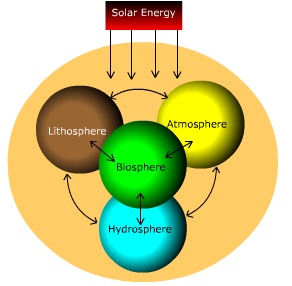The Hydrosphere 
The hydrosphere is often called the "water sphere" as it includes all the earth's water found in the oceans, glaciers, streams, lakes, the soil, groundwater, and in the air. The hydrosphere interacts with, and is influenced by, all the other earth spheres. The water of the hydrosphere is distributed among several different stores found in the other spheres. Water is held in oceans, lakes and streams at the surface of the earth. Water is found in vapor, liquid and solid states in the atmosphere. The biosphere serves as an interface between the spheres enabling water to move between the hydrosphere, lithosphere and atmosphere as is accomplished by plant transpiration. The hydrologic cycle traces the movement of water and energy between these various stores and spheres.
Figure 10.1 Earth Spheres/Systems
The cryosphere is the part of Earth's hydrosphere comprised of frozen water.
It plays a integral role in the global climate system through
its influence on surface energy budgets, atmospheric moisture, hydrology, and atmospheric and oceanic circulation.
The cyrosphere is a sensitive element of the climate system providing a key indicator of climate change. The increasing loss of Arctic sea ice and breakup of Antarctic ice shelves are two harbingers of changes to the future physical geography of Earth.
Video: Tour of the Cryosphere
Courtesy NASA